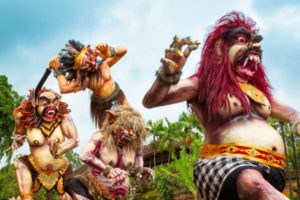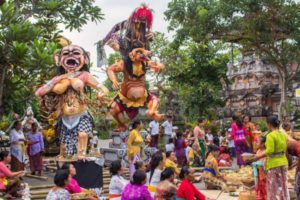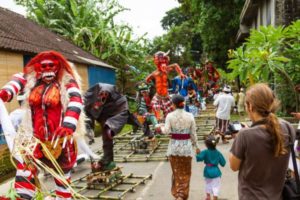Heck YA!! (There Are LOTS of Reasons!!)
The Island of the Gods has everything from culture and customs, temples and tradition, pre and post diving, warm and welcoming locals, festivals and festivities, waterfalls and walking tours, luxury and local dining. There are a many luxury resorts and local home-stays to choose from and inexpensive spa experiences all the way up to inclusive yoga retreats. If you’re looking to shop till you drop, then Bali offers everything from Burberry to Bintang singlets.
We understand people who only want to be underwater during their holidays, and we’ll talk about that later in the blog. Equally, if you like to explore the places you dive, a Bali stopover has options to please just about every budget and interest.
The following list by no means includes all there is to see and do in Bali; we’ve tried to give you some idea of what’s available. After 20 years of operating in Bali, we have found our dive guests often come away with enjoyable experiences from the following places.
Temples and Traditions
You don’t want to bore your non-diving friends and family with 500 underwater photos. Stopover in Bali and see a few Balinese temples during your dive holiday.
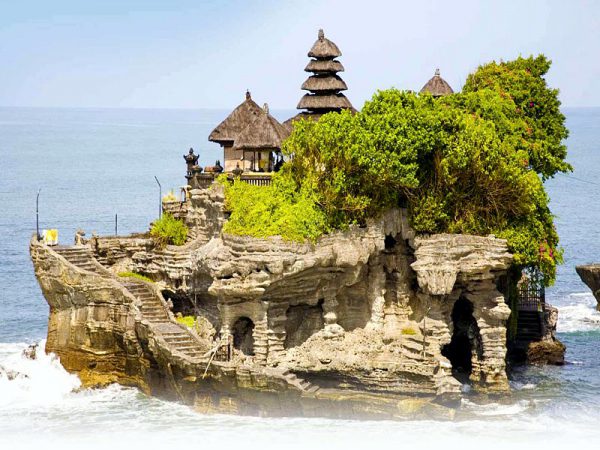
Tanah Lot
Tanah Lot Temple is one of Bali’s most important landmarks, famed for its unique offshore setting and sunset backdrops. An ancient Hindu shrine perched on top of an outcrop amidst constantly crashing waves; Tanah Lot Temple is among Bali’s iconic places.
Uluwatu
Pura Luhur Ulu Watu is one of six key temples believed to be the spiritual pillars of Bali. It sits perched on top of a steep cliff approximately 70 meters above sea level with commanding sea views to the west. This makes it a fantastic place to watch the local Kecak (fire dance) at sunset followed by a sumptuous dinner.
Goa Gajah
Dating to the ninth century, Goa Gajah (‘Elephant Cave’) is an archaeological site of significant historical value; it’s also a really cool place to explore. Take an hour to descend to its relic-filled courtyard and view the rock-wall carvings, a central meditational cave, bathing pools and fountains.
Gunung Kawi Temple Complex
One of Bali’s most unique archaeological sites comprising a collection of ten Candis (ancient shrine reliefs) carved into the face of a rock cliff. The main site overlooks the sacred Pakerisan River, which also flows by the Tirta Empul Temple a kilometer to the north.
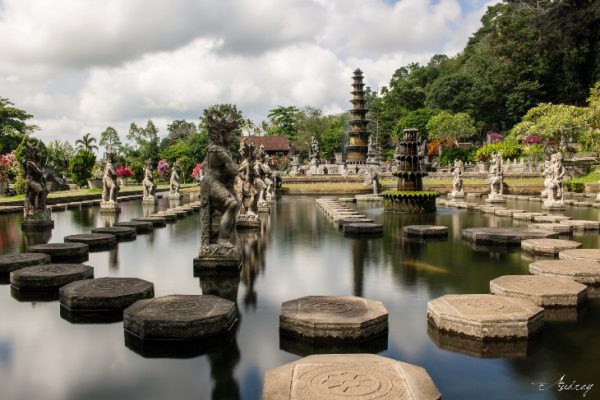 Pura Ulun Danu Bratan
Pura Ulun Danu Bratan
Built in 1926, it is the second most important temple complex of Bali, after the mother temple Besakih. The temple is dedicated to Dewi Batari Ulun Danu, goddess of lakes and rivers. “Ulun Danu” literally translates as “head of the lake.”
Tirta Gangga
The lavish water gardens owned by the royal Karangasem family feature 120 yards of pools, ponds, and fountains surrounded by neatly cut lawns adorned with stepping stones, ornate statues and tropical gardens.
Monkey Forest
Besides watching playful monkeys in their natural habitat, swinging through canopies, lazing along pathways or feeding on bananas, the site offers cool walks along paved pathways through a leafy nutmeg forest. Beautiful ancient temples with guardian statues covered in moss also feature throughout the forest.
Culture & Customs
So you have something other than your diving to talk about, stopover in Bali and learn a little about the Balinese culture & customs during your dive holiday! Balinese culture is a mix of Balinese Hinduism religion and local customs. Minority religions are Islam, Christianity, and Buddhism. It is perhaps most well known for its dance, drama and sculpture. Even in poor rural villages, beautiful temples are a common sight and so are skillful gamelan players and talented actors and dancers. The Balinese Culture is truly awe-inspiring and the locals are some of the warmest, friendliest people you’ll meet anywhere. Bali Magazine’s calendar of events is a good reference for ceremonies and performances both large and small.
Melasti – March 25, 2017
Pilgrims take heirlooms on long walks from temples towards the coastlines where purification rites take place. Parasols, banners and small effigies paraded along the horizon make for a stunning and only-in-Bali scene.
Saka, New Year’s Eve March 27, 2017
A night of merriment and noise, every Balinese household starts the evening with blessings at the family temple and continues with a ritual to ‘chase away’ malevolent forces, known as bhuta kala, from their compounds – hitting pots and pans or any other loud instruments along with a fiery bamboo torch. These ‘spirits’ are later manifested as the ogoh-ogoh to be paraded in the streets. As the street parades ensue, bamboo cannons and occasional firecrackers fill the air with flames and smoke.
- Ogoh-ogoh Statues at the Ngrupuk Parade
Nyepi, Day of Silence – March 28, 2017
Nyepi Day in Bali is a New Year celebration unlike anywhere else on the planet. This day of silence is ultimately the quietest day of the year when all of the island’s inhabitants abide by a set of local rules, which brings all routine activities to a complete halt. The airport and roads all over Bali are devoid of any traffic and nobody steps outside of their home compounds
Gulangan and Kuningan – April 4th & November 1, 2017
Galungan enlivens the whole island of Bali with locally made Penjors (beautifully decorated bamboo poles) lining all the roads on the island. For 10 days this festival celebrates the creation of the universe; the victory of the good Dharma against the evil Adharma. It is believed that the gods come down to earth and ancestors’ souls pay a visit to their families.
Bali Arts Festival – June 10th through July 8th
The Bali Arts Festival is a cultural treat for lucky visitors who are in Bali around mid-July. It is the perfect moment to witness Bali’s wealth of artistic creativity together with various cultural highlights from other islands in Indonesia. It kicks off with a parade that showcases traditional costumes and culture from regions throughout Indonesia.
Smaller cultural performances are held regularly throughout the island but Ubud’s a great place to start looking, as it is Bali’s artistic heart.
Kecak and Trance Dance
The kecak is a ritual dance that was created for the 1933 movie “Island of the Demons” by the German painter and intellectual Walter Spies, Victor Von Plessen and Friedrich Dalsheim. The dance combines the chorus of the “Sanghyang” trance dance with a dance story from the Indian epic poem “Ramayana.”

Legong and Mahabharata
The Legong is a very difficult dance requiring great dexterity and is generally performed by young girls. The dance is choreographed to the finest detail with no improvisation allowed.
Barong and Kris Dance
The Barong is a triumphant display of graceful movement and vibrant color. The dance is a contest between the opposing forces of Rangda, representing chaos and destruction, and Barong, representing order.
Ramayana Ballet
This highly entertaining dance form plays out the epic legends of the Ramayana. The ballet tells an adventurous tale broken into four scenes that include kidnapping, travel, and death. The dancers do not converse with each other. The story is narrated only by the “sinden”, a female singer present throughout the piece.
Diving in Bali Before or After your Dive Holiday
Bali and the surrounding islands have amazingly diverse diving. We highly recommend that guests stopover and dive Bali before or after their dive trips in other parts of the archipelago. It’s a great place to get your feet wet, make sure your gear is working properly and see some amazing marine life that you may not see elsewhere. Starting clockwise let’s take a dive tour around Bali.
Northwest Bali
Day trips to dive the Northwest are not a good option as the distance is too great. You’ll want to book a place to stay somewhere near Pemuturan or Lovina (Kalibukbuk). From there you can easily access the popular sites in the area.
Most of the diving in the Northwest is located in two areas. Menjangan Island – Menjangan Island is a small island off the coast that is situated in the marine preserve of the Bali Barat National Park. If you are looking for coral and fish this is your place. It is known for walls and nice colorful reefs with lots of reef fish. Secret Bay – Incredible macro subjects await. Due to a stilty bottom and tides, viz can be limited, so go with someone who knows the area well. Another amazing “muck” dive in the central region of the north is Puri Jati where your guides will be on the lookout for mimic octopus and other fun macro subjects.
Staying in the Area? If you plan to spend a week diving in North Bali, be forewarned that there just aren’t enough dive sites for 3 dives a day. Be prepared to spend a little time relaxing or doing some day excursions. If you are looking for a bit more action Lovina has some nightlife and restaurants in a central area, although it’s still sleepy compared to South Bali.
- Matahari Beach Resort and Spa
- Menjangan Resort or Taman Sari Bali
- Pondok Sari Beach Resort, Spa and Dive Center
- Tirta Sari (across from Pondok Sari dive center)
For a special treat check out Puri Jati Retreat. Located near the Puri Jati dive site this is a private villa owned by two divers that live and work in the Indonesian archipelago.
Northeast Bali
Tulamben
Although day trips are available from the south, why spend 1.5 – 3 hours each way in a car. Instead, you can go up, stay awhile, do some great diving, and enjoy the quiet mornings and spectacular sunrises that light up Mt. Agung. Plus night dives in Tulamben can be amazing and a two-hour drive home after isn’t going to be the highlight.
Central Tulamben (Liberty Wreck) and central Amed are only 45 minutes by car from each other. You can easily stay in one area and drive to the other depending on where the dive winds are blowing that day. Dive centers will generally set this up for an additional fee. While Tulamben attracts many of the divers in the Northeast, Amed is becoming more popular with people looking for smaller crowds.
Tulamben refers to a sprawling area with many beautiful sites to choose from. Most divers would agree that southern Tulabmen’s most famous “muck” site is Sereya’s Secret, but Melasti is great too! Basically, that whole stretch of beach is super-productive for macro. Farther up the coast you don’t want to miss the U.S.S. Liberty. This WWII vintage, 120m long cargo vessel is covered with life. Farther still up the coast are Kubu Drop Off and Coral Gardens; both are easily accessible reef dives. Equally fabulous and less crowded are dive sites north near Baturinggit. Resorts there have secret “muck” sites in addition to reef sites like Ulami and Out of Eden.
The following hotels have a reputable dive center located on property.
- Villa Markisa Dive Resort & Alam Batu Dive Resort – Both properties have standard rooms available for budget minded travelers
- Liberty Wreck in Tulamben
- Blue Hill Tulamben
Amed
Amed is a series of bays; each bay has a cluster of small hotels and home stays, restaurants, dive centers and shops. While less well known than its northern neighbor, Amed also has some diving gems. The highlight at Jemuluk Kayu Putih is a pinnacle that rises from 25m and has a scenic swim-through at 20m. Ghost Bay is the place for rare species like the clown frogfish, different kinds of ghost pipefish and mimic octopus. The Japanese Wreck, a 20m long patrol boat sunk during the war, rests in a lovely coral garden and is covered in soft corals and reef fish. The top of it, at only 3m is shallow enough to snorkel and the deepest part is just 12m so it’s perfect for an easy (and long) dive.
- Griya Villas Amed
- Arya Amed Beach Resort & Dive Center
- Baliku Dive Resort Amed
- Puri Wirata Dive Resort Amed
There are so many options for a stopover in Bali before or after your dive holiday that we can’t possibly cover them all in this blog. While we started our Bali dive tour in the Northwest, Part II will cover dive areas on Bali’s east coast and outlying islands. Part II will also have more information on trekking and sightseeing the natural wonders of Bali and of course, our favorite restaurant experiences and fun shopping ideas (some that are as much about culture as they are about souveniers). Link to our list of sailing dates to help plan your Bali stopover.





